ISKCON & Raganuga Bhakti part 3
Mahanidhi Madan Gopal Das
Due to unclear verse translations and purports in Srila Prabhupada’s books like “Nectar of Devotion” and “Sri Chaitanya-caritamrita”, many ISKCON members misunderstand and misrepresent the authorized practice of raganuga-bhakti sadhana.
This post will cite these confusing translations and purports, and give clear explanations of the subject of raganuga-bhakti.
WHAT ABOUT SIDDHA PRANALI?
Srila Prabhupada says, “In this connection, we should be careful about the so-called siddha-pranali. The siddha-pranali process is followed by a class of men who are not very authorized and who have manufactured their own way of devotional service.”
Comment: Does this include Sri Bhaktivinoda Thakura, whom Srila Prabhupada himself has made world-famous as an acarya? Bhaktivinoda personally took siddha-pranali from his guru, Sri Bipin Bihari Goswami, and described it in his books Hari-nama cintamani and Jaiva-dharma.
Srila Prabhupada says, “They imagine that they have become associates of the Lord simply by thinking of themselves like that.”
Clarification: Yet, this is exactly what the acaryas say. Sri Jiva Goswamipada says in Bhakti Sandarbha 286, “Bhuta-shuddhi means that one meditates on one’s own desired siddha deha which is fit for serving Bhagavan Sri Krishna.”
Sri Krishnadas Kaviraja Goswami says in Sri Chaitanya-caritamrita (2.22.155-6): “Think of your own desired siddha deha as a sadhana.”
In that very same Nectar of Devotion, Sri Rupa Goswamipada says the same thing (Bhakti-rasamrita-sindhu 1.2.295), plus its tikas by Sri Jiva Goswamipada and Visvanatha Cakravartipada.
Narottama Dasa Thakur says, “Whatever siddha deha one thinks of during one’s sadhana is what one attains in siddha stage.” (Prema Bhakti Candrika)
In Saranga-rangada tika of Krishna Karnamrita (3), Sri Krishnadas Kaviraja Goswami says:
raganuga -marge -anutpanna -rati sadhaka -bhaktair -api -svepsita -siddha -deham -manasi -parikalpya
“On the raganuga-path even sadhaka bhaktas who have no bhava [rati] yet can think of one’s own desired siddha deha.”
Srila Prabhupada says, “The so-called siddha-pranali process is followed by the prakrta-sahajiya, a pseudo sect of so-called Vaishnavas. In the opinion of Rupa Gosvami, such activities are simply disturbances to the standard way of devotional service.”
Comment: Where does Rupa Gosvami say this in Bhakti Rasamrita Sindhu?
Srila Prabhupada: “Sri Rupa Gosvami says that learned acaryas recommend that we follow the regulative principles even after the development of spontaneous love for Krishna.”
CLARIFICATION: Here Srila Prabhupada contradicts himself (see above): “These raganuga devotees do not follow the regulative principles of devotional service very strictly.”
In their tikas to Bhakti-rasamrita-sindhu (1.2.292), both Sri Jiva Goswamipada and Visvanatha Cakravartipada say: “When one has got even a slight feeling [kinchit anubhuti] for the sweet moods of Krishna and His devotees through hearing their descriptions in texts i.e Srimad Bhagavatam describing the ultimate spiritual goal, the raganuga sadhaka no longer waits for the injunctions of scripture or for logical reasons to do so, but simply takes up the raganuga devotional path. This is the characteristic of sacred greed, lobha.”
The words yat kinchit [slight, little] in their tikas prove that the initial lobha, sacred greed, to start raganuga-bhakti is not an all-consuming fire.
NO RULES IN RAGANUGA-BHAKTI?
In Nectar of Devotion, chapter 16 – “Eligibility for Spontaneous Devotional Service”, Srila Prabhupada says: “Persons desiring to follow in the footsteps of such eternal devotees of the Lord as the Vrsnis and Vrindavan denizens are called raganuga devotees, which means that they are trying to attain to the perfection of those devotees. These raganuga devotees do not follow the regulative principles of devotional service very strictly…”
Clarification: This has turned out to be a disastrous statement when preaching to a modern audience. People now think that raganuga bhakti means one need not follow the principles of chastity and restraint. Believe it or not, today there are some who preach that a life of illicit amorous relations, drugs and rock music is raganuga bhakti.
But Sri Rupa Goswamipada never said that raganuga bhakti means one need not follow the rules. Rather, Visvanatha Cakravartipada has written a book, ‘Raga Vartma Candrika’ specially to warn against such a conception.
He ends that book with: “Those who say that raganuga bhakti totally surpasses all scriptural injunctions in all respects have always caused disturbance, are causing disturbance and will cause disturbance.”
WHY ALWAYS GOPI-BHAVA?
“Why it has to be always gopi-bhava, why can’t one become a cowherd boy?”
Sri Chaitanya-caritamrita is the gist of the Gaudiya Vaishnava dharma, the ultimate statement, and it opens with this verse of Sri Rupa Goswamipada, stating the purpose of Sri Chaitanya’s advent:
“May Chaitanya Mahaprabhu who is known as the son of Srimati Saci-devi be transcendentally situated in the innermost chambers of your heart. Resplendent with the radiance of molten gold, Mahaprabhu has appeared in the Age of Kali by His causeless mercy to bestow what no avatara has ever offered before: the elevated divine erotic flavor relished by Radha-Krishna [unnatojjvala-rasam]. (Sri Chaitanya-caritamrita 1.1.4)
Sri Chaitanya-caritamrita (1.4.44-45) says: “But if we compare the sentiments in an impartial mood, we find that the conjugal sentiment is superior to all others in sweetness.
“Increasing love is experienced in various tastes, one above another. But that love which has the highest taste in the gradual succession of desire manifests itself in the form of conjugal love.”
The standard songs in the entire Gaudiya Vaishnava Sampradaya, including ISKCON, all point at gopi-bhava and madhura rasa upasana. The “Tulasi-arati” for instance:
ei -nivedana -dharo, sakhira -anugata -koro
seva -adhikara -diye -koro -nija -dasi
“O Tulsi-devi, I submit to you to please make me a follower of the sakhis, and make me your maidservant by giving me to right to serve you.”
And the Gurvastakam (6):
nikunja-yuno -rati-keli-siddhyai
ya -yalibhir -yuktir -apeksaniya
tatrati-daksyad -ati-vallabhasya
vande -guroh -sri-caranaravindam
“The spiritual master is very dear, because he is expert in assisting the gopis, who at different times make different tasteful arrangements for the perfection of Radha-Krishna’s amorous affairs within the groves of Vrindavan. I offer my most humble obeisances unto the lotus feet of such a spiritual master. “
It should be noted that most of the acaryas in ISKCON’s parampara are all manjari maidservants of Radharani in the spiritual realm.
Furthermore, at diksha the Kama-Gayatri is given to all Gaudiya Vaishnava, indicating that Krishna needs to be worshipped as the transcendental Cupid of Vrindavan. How does this fit in with being a cowherd boy, parent or male servant of Krishna? There is also not a single Vaishnava community in the world which practices cowherdboy, parent, or servant rasa. [content courtesy Sri Advaita Dasji]
Raganuga-bhakti ki jai! Jai Jai Sri Radhe!

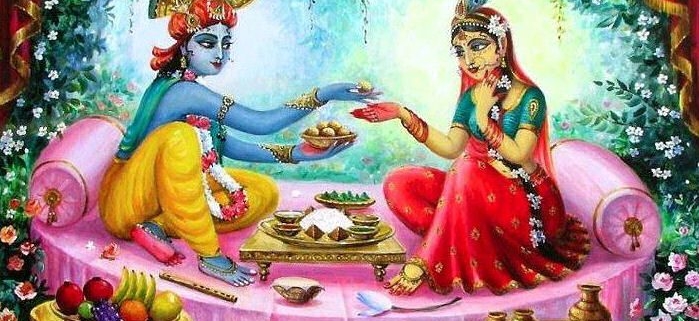

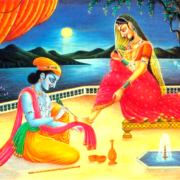
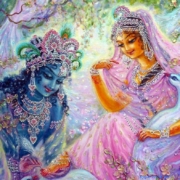
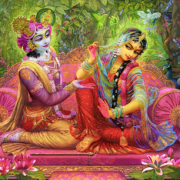
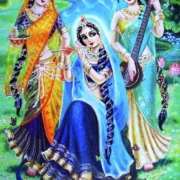
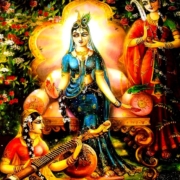
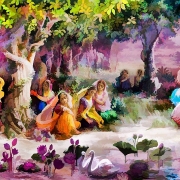
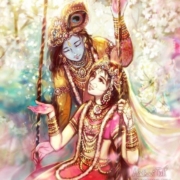


Leave a Reply
Want to join the discussion?Feel free to contribute!